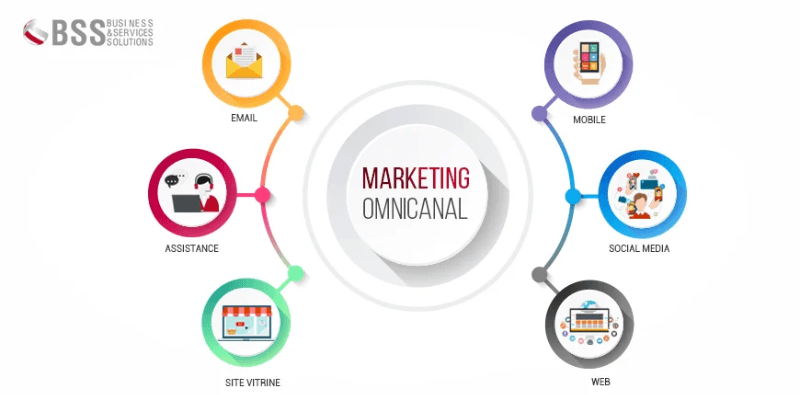Omni-Channel Marketing: Importance, Examples & How to Implement
- Key Takeaways
- Understanding Omni-Channel Marketing
- Key Differences from Multichannel Approaches
- Importance of Omni-Channel Strategies
- Successful Strategy Examples Across Industries
- Benefits of Adopting Omni-Channel Marketing
- Steps to Implement Effective Strategies
- Data Collection for Omni-Channel Success
- Customer Journey Mapping Essentials
- Personalization Techniques for Engagement
- Closing Thoughts
- Frequently Asked Questions
- What is omni-channel marketing?
- How does omni-channel differ from multichannel marketing?
- Why are omni-channel strategies important?
- Can you provide examples of successful omni-channel strategies?
- What are the benefits of adopting an omni-channel approach?
- What steps should businesses take to implement effective omni-channel strategies?
- How can data collection contribute to omni-channel success?

Omni-channel marketing is a strategy that integrates multiple channels to create a seamless customer experience. This omnichannel marketing approach allows businesses to reach consumers through various platforms, including social media, email, and in-store interactions. By utilizing omnichannel marketing, companies can enhance customer engagement and increase brand loyalty.
Effective implementation of this omnichannel marketing strategy requires understanding consumer behavior and preferences across different touchpoints. It enables brands to deliver consistent messaging and personalized experiences. As the digital landscape evolves, mastering omnichannel marketing becomes essential for businesses aiming to thrive in a competitive environment. This post will explore the key components and benefits of adopting an omnichannel approach to marketing.
Key Takeaways
- Embrace an Omni-Channel Approach: Shift your marketing strategy to include all channels, ensuring a seamless experience for customers, as highlighted in the section on "Understanding Omnichannel Marketing."
- Differentiate from Multichannel: Recognize the key differences between omni-channel and multichannel strategies to better tailor your marketing efforts, as discussed in " Key Differences from Multichannel Approaches."
- Leverage Successful Examples: Study successful omni-channel strategies from various industries to inspire your own approach, referenced in "Successful Strategy Examples Across Industries."
- Collect and Analyze Data: Use data collection techniques outlined in "Data Collection for Omni-Channel Success" to understand customer behavior and improve your marketing strategy.
- Map the Customer Journey: Create a detailed customer journey map, as mentioned in " Customer Journey Mapping Essentials," to enhance customer experiences across all touchpoints.
- Focus on Personalization: Implement personalization techniques from "Personalization Techniques for Engagement" to better connect with your audience and increase engagement.
Understanding Omni-Channel Marketing

Definition
Omni-channel marketing is a seamless approach that connects various channels. This includes online platforms, physical stores, and mobile apps. The goal is to enhance the customer experience. Customers can interact with a brand in multiple ways. They might shop online, visit a store, or use an app. Each interaction should feel consistent and integrated.
Unified Brand Presence
Creating a unified brand presence is crucial in omni-channel marketing. Brands need to maintain the same message across all platforms. This consistency builds trust and recognition among consumers. For example, if a customer sees an ad on social media, it should reflect what they find on the website or in-store. Discrepancies can confuse customers and harm brand loyalty.
Customer-Centric Strategies
Omni-channel marketing focuses on customer-centric strategies. It aims to meet consumer needs effectively. Understanding the customer journey is key to this approach. Brands must analyze how customers move between channels. For instance, some may start their shopping online and complete it in-store. Others may research products in-store before buying online.
Engaging Omni-Channel Experiences
Providing engaging omni-channel experiences is essential for success. Brands should personalize interactions based on customer preferences. Using data analytics helps brands understand individual behaviors. This leads to tailored promotions and recommendations. Personalized omni-channel marketing increases engagement and satisfaction.
Benefits of Omni-Channel Marketing
- Improved Customer Experience: Customers enjoy a smoother shopping process.
- Increased Sales: A seamless experience often leads to higher conversion rates.
- Enhanced Customer Loyalty: Consistent engagement fosters brand loyalty.
- Better Insights: Data from various channels provides valuable insights into consumer behavior.
Examples of Successful Omni-Channel Campaigns
Many brands have successfully implemented omni-channel marketing strategies. Retail giants like Target and Walmart use these methods effectively. They offer options like buy online and pick up in-store (BOPIS). This flexibility meets diverse customer needs.
Challenges in Implementation
Implementing an effective omni-channel marketing strategy can be challenging. Brands must integrate technology across all platforms. They also need to train staff to ensure a consistent customer experience. Managing inventory across channels requires careful planning.
Key Differences from Multichannel Approaches

Integration Focus
Omni-channel marketing stands out because it emphasizes integration across all platforms. This approach connects various channels into a single, unified experience for the customer. In contrast, the multichannel approach focuses on individual channels without ensuring they work together. Each channel operates independently, which can lead to inconsistencies in messaging and customer experience.
Omni-channel strategies use technology to track customer interactions across different channels. This allows brands to understand how customers move from one channel to another. For example, a customer may start shopping online, then visit a physical store, and finally complete their purchase through a mobile app. The omni-channel model captures this journey and provides a seamless transition.
Customer Journey
Omni-channel marketing prioritizes the customer journey as a whole. It considers every touchpoint and interaction that a customer has with the brand. These interactions are designed to be smooth and enjoyable. Multichannel strategies often treat each channel separately. This can result in disjointed experiences for customers who switch between channels.
For instance, if a customer receives an email promotion but finds different pricing on the website, frustration can arise. An omni-channel strategy aims to eliminate such issues by ensuring consistent information across all platforms. This creates a more satisfying experience for the customer.
Cohesive Experience
The goal of omni-channel marketing is to provide a cohesive experience. Customers should feel like they are interacting with one brand, regardless of the channel they use. On the other hand, multichannel marketing can lead to fragmented interactions. Different channels may communicate different messages or offer varying levels of service.
In practice, this means that if a customer reaches out via social media but receives different support than through email, confusion may occur. Omni-channel strategies strive to avoid this by maintaining continuity in communication and service quality across all points of contact.
Summary of Differences
- Integration vs. Individuality: Omni-channel integrates channels while multichannel treats them separately.
- Customer Journey: Omni-channel focuses on the entire journey; multichannel often overlooks connections.
- Cohesiveness vs Fragmentation: Omni-channel ensures a unified experience; multichannel can create confusion.
These differences highlight why brands should consider adopting an omni-channel approach over traditional multichannel strategies. A cohesive and integrated system enhances customer satisfaction and loyalty.
Importance of Omni-Channel Strategies

Customer Retention
Omnichannel marketing strategies significantly enhance customer retention. They create consistent engagement across various platforms. When customers interact through multiple online channels, they feel more connected to the brand. This connection encourages repeat purchases.
A good omnichannel strategy ensures that customers receive the same experience whether they shop online or in-store. For example, a customer may start their journey on a brand's website and later visit a physical store. If both experiences align, it builds trust. Trust leads to loyalty and keeps customers coming back.
Brand Loyalty
Omnichannel strategies play a vital role in building brand loyalty. Personalized experiences are at the heart of these efforts. Customers appreciate when brands understand their preferences. By using data from different touchpoints, businesses can tailor their offerings.
For instance, if a customer frequently buys running shoes, an integrated omnichannel strategy can send them targeted promotions for related products. This level of personalization enhances the shopping experience. It makes customers feel valued and understood, which fosters loyalty.
Competitive Advantage
Adopting an omnichannel approach provides a competitive edge in today's market. Businesses that implement successful omnichannel marketing strategies can stand out from competitors. They offer seamless transitions between channels, improving customer satisfaction.
Companies with strong omnichannel retail strategy specialization can respond quickly to market trends. They can analyze customer behavior across all channels and adjust their strategies accordingly. This adaptability is essential in a fast-paced environment.
Moreover, businesses that focus on omnichannel supply chains can streamline operations. Efficient supply chains ensure that products are available where and when customers want them. This reliability further enhances the overall customer experience.
Consistency Across Channels
Consistency is crucial in an effective omnichannel marketing strategy. Customers expect uniform messaging and branding across all social media channels and online touchpoints. A lack of consistency can confuse customers and damage brand reputation.
Brands that maintain consistent communication build stronger relationships with their audience. They create a recognizable identity that resonates with consumers. This recognition leads to increased trust and loyalty over time.
Summary
In summary, omni-channel strategies improve customer retention through consistent engagement and personalized experiences. They enhance brand loyalty by making customers feel valued. Furthermore, businesses gain a competitive advantage by adopting these approaches in today's market.
Successful Strategy Examples Across Industries

Retail Giants
Walmart is a prime example of successful omni-channel marketing. The retail giant integrates its online and in-store experiences. Customers can order products online and pick them up in stores. This strategy has led to significant growth in sales, especially during the pandemic. Walmart reported a 79% increase in e-commerce sales in 2020.
Target also excels in this area. They offer same-day delivery through their app and website. Customers appreciate the convenience of shopping from home while having products delivered quickly. This approach has boosted customer satisfaction and increased overall ROI.
E-Commerce Leaders
Amazon sets the standard for omni-channel marketing in e-commerce. Their seamless integration of online shopping with physical stores enhances customer experience. Amazon's acquisition of Whole Foods allowed them to blend grocery shopping with their digital platform. Customers enjoy ordering groceries online and picking them up at local stores.
Zalando, a European fashion retailer, showcases another effective strategy. They provide customers with personalized shopping experiences across various channels. Their mobile app allows users to browse and purchase items easily. Zalando’s focus on user experience has resulted in higher customer retention rates.
Technology Apps
Starbucks uses an app to create a unique omni-channel experience. Customers can order drinks ahead of time and pay through the app. This reduces wait times and enhances convenience. Starbucks reports that over 25% of transactions occur through their mobile app, highlighting its effectiveness.
Sephora also leverages technology to improve customer engagement. Their mobile app offers features like virtual try-ons and personalized product recommendations. This strategy connects online shoppers with in-store experiences, leading to increased sales and brand loyalty.
Measurable Outcomes
Successful omni-channel campaigns yield measurable outcomes. Brands see increased sales as they connect with customers across multiple platforms. According to a study by Harvard Business Review, companies with strong omni-channel strategies retain 89% of their customers compared to 33% for those with weak strategies.
Customer satisfaction also improves significantly. Consumers appreciate consistent experiences whether they shop online or in-store. A well-executed omni-channel strategy fosters stronger relationships between brands and customers.
Industry Adaptations
Different industries apply these strategies uniquely based on their target audiences. For instance, the travel industry uses omni-channel marketing to enhance customer journeys. Airlines allow customers to book flights online while providing updates via apps or emails.
Similarly, the automotive industry uses omni-channel strategies for car buyers. Potential customers can research cars online, schedule test drives through apps, and even complete purchases digitally.
Benefits of Adopting Omni-Channel Marketing

Improved Insights
Omni-channel marketing provides businesses with better customer insights. By leveraging data from various channels, brands can understand consumer behavior more deeply. This understanding allows for better-targeted marketing efforts. For example, analyzing social media interactions helps identify customer preferences and trends. Brands can then tailor their messaging to resonate with their audience.
These insights lead to more effective campaigns. Companies can segment their audience based on behaviors and interests. This segmentation increases the chances of reaching the right customers at the right time. As a result, marketing becomes more efficient and impactful.
Increased Sales Conversion
Enhanced customer engagemen t across channels significantly boosts sales conversion rates. Customers today expect seamless experiences. They want to interact with brands through multiple platforms, such as websites, social media, and email. When brands meet these expectations, they foster loyalty and trust.
For instance, a consumer might see a product on social media and later visit the brand’s website to purchase it. If the journey is smooth, the likelihood of conversion increases. Studies show that companies using omni-channel strategies see up to a 30% increase in sales conversions compared to those using single-channel approaches.
Cost Efficiency
Cost efficiencies are another key benefit of omni-channel marketing. Streamlined processes allow companies to allocate resources effectively. By integrating various marketing channels, businesses can reduce redundancy in efforts and spending.
For example, a company can run a single campaign across multiple platforms instead of separate campaigns for each channel. This approach saves time and money while maintaining consistency in branding. It also leads to better resource management, ensuring that marketing budgets are used wisely.
Moreover, companies can analyze which channels yield the best return on investment (ROI). This analysis enables them to focus their efforts where they matter most. As a result, brands experience improved overall performance at reduced costs.
Steps to Implement Effective Strategies

Conduct Audit
A comprehensive audit of existing marketing channels is the first step. This process helps identify what is currently working and what is not. Businesses should evaluate their online and offline channels. They must analyze customer interactions across social media, email, and physical stores.
This audit provides valuable insights into customer behavior. It reveals gaps in communication and areas for improvement. Understanding these factors lays the groundwork for a successful omni-channel strategy.
Define Goals
Defining clear goals and objectives is crucial for the omni-channel strategy. Specific goals guide the direction of marketing efforts. For example, a business might aim to increase customer engagement by 20% within six months.
These objectives should be measurable and realistic. Setting clear targets helps teams stay focused. It also allows for tracking progress toward achieving those goals. Without defined objectives, businesses may struggle to align their strategies effectively.
Develop Technology Infrastructure
Developing a robust technology infrastructure is essential for supporting omni-channel marketing. This infrastructure enables data integration and customer tracking across multiple platforms. Businesses need to invest in tools that collect and analyze customer data.
For instance, Customer Relationship Management (CRM) systems can track interactions across various channels. This information helps create personalized experiences for customers. A seamless technology setup enhances communication between different departments.
Effective integration leads to better data management. Companies can make informed decisions based on real-time analytics. This approach ultimately improves the return on investment (ROI) from marketing campaigns.
Last Step: Continuous Improvement
The last step involves continuous improvement of the omni-channel strategy. Regularly reviewing performance metrics is vital. Businesses should assess whether they meet their defined goals.
Adjustments may be necessary based on customer feedback or market trends. Adapting strategies ensures they remain relevant and effective over time.
Data Collection for Omni-Channel Success

Key Metrics
Shoppers interact with brands through multiple channels. Tracking specific metrics helps businesses understand their behavior. Important metrics include conversion rates, customer acquisition cost, and customer lifetime value.
Conversion rates show how many visitors complete a desired action. This can be making a purchase or signing up for a newsletter. Customer acquisition cost measures the expense incurred to gain new customers. Knowing this helps businesses allocate budgets effectively.
Customer lifetime value is crucial for long-term success. It estimates the total revenue a customer will generate over their relationship with a brand. By analyzing these metrics, companies make informed decisions about marketing strategies.
Analytics Tools
Utilizing analytics tools is essential for effective data collection. These tools help gather information from various touchpoints. Google Analytics and Adobe Analytics are popular choices among businesses.
These platforms provide insights into customer behavior. They track how shoppers navigate websites and mobile apps. Businesses can monitor which items are most popular and when shoppers tend to buy them.
Analytics tools help identify trends in shopping patterns. For instance, if data shows an increase in mobile shopping, companies can adjust their marketing efforts accordingly. This adaptability leads to better engagement with consumers.
Regular Updates
Regular updates of data collection methods are vital. Consumer preferences change over time. Brands must adapt their strategies to stay relevant.
Conducting reviews of existing data collection techniques helps identify gaps. If certain channels yield little information, it may be time to explore new options. Surveys and feedback forms can provide valuable insights directly from shoppers.
Incorporating real-time data collection enhances decision-making processes. Businesses should implement systems that allow for immediate analysis of gathered data. This ensures they stay ahead of market trends and consumer demands.
Adapting to changes in shopper behavior is crucial for omni-channel marketing success. Brands that remain flexible can respond quickly to shifting preferences. This responsiveness builds trust and loyalty among consumers.
Customer Journey Mapping Essentials

Mapping Process
Creating detailed customer journey maps is crucial. This process involves visualizing all the touchpoints a customer interacts with. Start by identifying each stage of the journey. These stages include awareness, consideration, purchase, and post-purchase experiences.
Next, gather data on customer interactions across various platforms. This data can come from surveys, interviews, and analytics. Use this information to plot out each touchpoint. Each point should represent a moment where the customer engages with the brand. For example, a customer may first see an ad online, then visit the website, and finally make a purchase in-store.
Visualizing these interactions helps businesses understand the complete customer experience. A well-structured map highlights how customers move through their journey. It also shows how different channels work together to create a seamless experience.
Identifying Pain Points
Identifying pain points within the customer experience is essential for improvement. Pain points are moments where customers face difficulties or frustrations. These could be long wait times during checkout or unclear product information online.
By pinpointing these issues, businesses can take action to enhance the overall journey. For instance, if customers frequently abandon their shopping carts, it may indicate a problem with the checkout process. Addressing these concerns can lead to increased customer loyalty.
Moreover, opportunities for improvement often arise from these pain points. Businesses can innovate solutions that not only fix issues but also enhance customer satisfaction. For example, offering clearer product descriptions or faster response times can significantly improve the shopping experience.
Cross-Functional Teams
Involving cross-functional teams is vital in creating comprehensive journey maps. Different departments bring unique insights about the customer experience. Marketing teams understand audience behavior, while sales teams know common customer questions.
Collaboration ensures that all perspectives are considered in the mapping process. Each team contributes valuable insights into how customers interact with products and services. This holistic view allows for better understanding and enhances the overall mapping effort.
For example, involving IT can help identify technical issues affecting online experiences. Likewise, including customer service representatives can highlight common complaints from customers.
Personalization Techniques for Engagement
Targeted Messaging
Targeted messaging is vital in omni-channel marketing. It relies on customer data to improve relevance. Businesses analyze consumer behaviors to craft messages that resonate. For example, if a customer frequently browses running shoes, tailored ads can highlight the latest models or promotions related to this interest.
This approach increases engagement. Consumers feel valued when they receive relevant information. Companies can use email campaigns to send personalized offers based on past purchases. This strategy not only enhances interactions but also boosts loyalty.
Dynamic Content
Dynamic content adapts to user behavior in real-time. This technique allows businesses to change what a customer sees based on their actions. For instance, a website might display different products when a user revisits after browsing previously.
Such optimization leads to better engagement rates. Customers are more likely to interact with content that reflects their preferences. Using dynamic content in ads and emails keeps the communication fresh and relevant. It encourages users to return, knowing they will find something tailored just for them.
AI and Machine Learning
AI and machine learning enhance predictive analytics. These technologies analyze vast amounts of data to anticipate customer needs. By understanding patterns in consumer behaviors, businesses can lead customers toward products they may be interested in.
For example, an online retailer can suggest items based on previous purchases and browsing history. This proactive approach fosters deeper connections with consumers. They feel understood and appreciated when brands predict their desires.
Leveraging these technologies requires a commitment to data collection and analysis. Companies must focus on gathering accurate information from various channels, including mobile apps and websites. The insights gained can inform marketing strategies and improve overall customer experience.
Rewards Programs
Reward programs encourage customer loyalty through engagement techniques. Many companies offer points or discounts for repeat purchases or social media interactions. This strategy motivates consumers to engage more with the brand.
For instance, Starbucks uses its loyalty program effectively. Customers earn stars for every purchase, leading to free drinks and exclusive offers. This not only drives sales but also creates a sense of community among users.
Closing Thoughts

Omni-channel marketing represents a transformative approach in today’s competitive landscape. It integrates various channels to create a seamless customer experience. This strategy enhances customer engagement and drives brand loyalty. By understanding the nuances of omni-channel versus multichannel approaches, businesses can tailor their strategies effectively. Successful examples illustrate its potential across diverse industries.
Implementing effective omni-channel strategies requires careful planning and execution. Data collection and customer journey mapping are essential for personalization. These steps ensure that brands meet consumer expectations consistently. Organizations must prioritize adopting these strategies to thrive in an evolving market. They should evaluate their current practices and consider integrating omni-channel marketing into their business model. The future of marketing hinges on this comprehensive approach, and now is the time to act.
Frequently Asked Questions
What is omni-channel marketing?
Omni-channel marketing is a strategy that integrates various channels to provide a seamless customer experience. It ensures consistent messaging and accessibility across platforms, enhancing customer engagement.
How does omni-channel differ from multichannel marketing?
While multichannel marketing uses multiple channels independently, omni-channel marketing creates a unified experience across all channels. Customers can transition seamlessly between platforms without losing context.
Why are omni-channel strategies important?
Omni-channel strategies enhance customer satisfaction by providing a cohesive shopping experience. They increase brand loyalty and drive sales by meeting customers where they are, ultimately improving retention rates.
Can you provide examples of successful omni-channel strategies?
Retailers like Nike and Starbucks excel in omni-channel marketing. They integrate online shopping with in-store experiences, offering personalized services and promotions that resonate with customers across all touchpoints.
What are the benefits of using omnichannel marketing in adopting an omni-channel approach?
Adopting an omni-channel approach leads to improved customer engagement, higher conversion rates, and increased brand loyalty. It allows businesses to gather valuable insights from various channels for strategic decision-making.
What steps should businesses take to implement effective omnichannel strategies, benefiting from omnichannel commerce and custom omnichannel marketing approaches?
Businesses should first analyze their current channels, define clear goals, and ensure data integration. Training staff and utilizing technology for real-time communication is also essential for success.
How can data collection contribute to omni-channel success?
Effective data collection enables businesses to understand customer behavior across channels. This information helps tailor marketing efforts, personalize experiences, and optimize strategies for better engagement and conversion rates.














